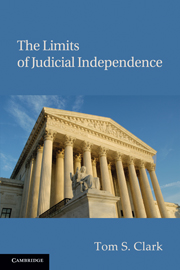Book contents
- Frontmatter
- Contents
- List of Tables
- List of Figures
- Acknowledgments
- 1 Introduction
- 2 A Political History of Court-Curbing
- 3 Conditional Self-Restraint
- 4 Court-Curbing and the Electoral Connection
- 5 Public Support and Judicial Review
- 6 Ideological Implications of Court-Curbing
- 7 The Limits of Judicial Independence
- Appendix A Elite Interview Methodology
- Appendix B Court-Curbing Bills, 1877–2008
- Bibliography
- Index
2 - A Political History of Court-Curbing
Published online by Cambridge University Press: 05 August 2012
- Frontmatter
- Contents
- List of Tables
- List of Figures
- Acknowledgments
- 1 Introduction
- 2 A Political History of Court-Curbing
- 3 Conditional Self-Restraint
- 4 Court-Curbing and the Electoral Connection
- 5 Public Support and Judicial Review
- 6 Ideological Implications of Court-Curbing
- 7 The Limits of Judicial Independence
- Appendix A Elite Interview Methodology
- Appendix B Court-Curbing Bills, 1877–2008
- Bibliography
- Index
Summary
To best understand the nature of conflict between the legislative and judicial branches, we begin with a political history of confrontations between Congress and the Court. In this chapter, I present a historical overview of the introduction of Court-curbing legislation. As I noted in the preceding chapter, Court-curbing refers to legislative attempts to limit or remove the Supreme Court's power (Stumpf 1965). Here I provide a detailed overview of the frequency with which Congress has engaged in Court-curbing, the types of legislation that have been proposed, and the partisan and ideological forces behind Court-curbing over time. I also identify several periods during which Court-curbing was particularly forceful and briefly describe the substantive disputes at issue. With this background in hand, subsequent chapters in this book develop a theoretical framework for understanding the causes and consequences of these periods of conflict.
THE POLITICS OF COURT-CURBING
Scholarship on the relationship between Congress, public opinion, and the Supreme Court suggests a connection between major political developments, shifts in public opinion, and judicial decision making. This work has focused most directly on the ability of governing coalitions to affect appointments to and the political leanings of the Court (Dahl 1957). For example, Adamany (1973) notes that major realigning elections – elections that have left the Court and the “lawmaking majority” out of step with each other – have historically been followed by periods of particular tension between the Court and Congress.
- Type
- Chapter
- Information
- The Limits of Judicial Independence , pp. 25 - 61Publisher: Cambridge University PressPrint publication year: 2010

